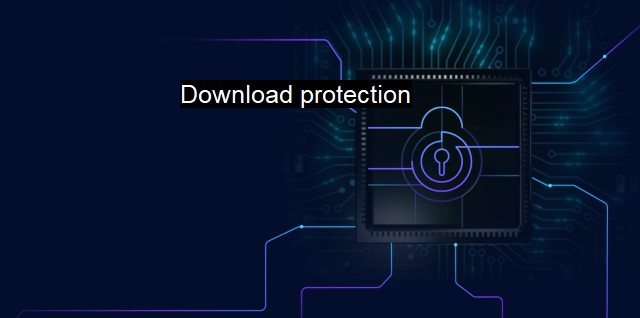What is Download protection?
Why Download Protection is Crucial in Modern Cybersecurity: The Role of Antivirus, Firewall and Intrusion Prevention Capabilities in Safeguarding External Source Downloads
Download protection is a critical aspect of cybersecurity strategy aimed to safeguard the integrity of computer systems. It entails having preventive security measures in place, such as hardwires, software, and policies to protect data or systems from viruses, malware, adware, and other potential cyber threats that can prove harmful when downloading files from the internet.The internet has become an essential part of our lives, with most of our critical information available online, necessitating robust protection against cyber threats. Cybersecurity includes practices like download protection to ensure the integrity, confidentiality, and availability of information.
"Download protection" is proactive, highlighting potential threats before they become issues. It begins with understanding the source of the file. Downloading data from unsafe or sketchy internet places poses a risk of virus, malware, and spyware invasion. Third-party sites with sharing services are often full of exposed links to such threats. As much as possible, users must stick to approved or trusted download sources.
Another element of download protection is antivirus software, specializing in preventing, detecting, and removing malware and other threats. antivirus programs look out for known virus patterns within a selected document or executable file, allowing the software to pick up even the minutest hint of a threat. The anti-downloading features in premium virus protection software alert the user if a webpage or download source suits standard safety criteria. These signals give consumers the power to mitigate any risks to their machines or devices.
Download protection also includes regularly updating software applications and installing security patches for quicker fixes and more vigorous safety layers. Software update releases often fix known or potential vulnerabilities and provide better defenses against new threats.
Download protection includes security measures like alerts against downloads from unsecured websites. These software-powered warnings are based on robust machine learning algorithms that enable users to evade often-invisible web threats.
Firewalls are also a staple in download protection, blocking unauthorized access while permitting outward communication. Firewalls create the first and most efficient layer in download protection strategy by keeping a stronghold control over inbound and outbound communication on networks.
Data encryption is another effective form of download protection that encodes information into cipher-text, only decipherable by authorized users with the decryption key. This cybersecurity method significantly reduces the risks when downloading files, particularly sensitive data.
Sustainable cybersecurity integrates continual employee education and training as a significant line of defense. Users must acknowledge the potential dangers of downloading corrupted files and be able to discern safe and unsafe download practices. They should be trained to recognize phishing scams and infected websites, and have a clear sense of what constitutes reliable antivirus protection.
Data from downloaded content is only as secure as its weakest link, meaning, if one component of the download protection strategy is prone to exploitation, then vulnerabilities can easily spiral, resulting in catastrophic outcomes. Hence, robust policies and proper analytics to audit potential vulnerabilities are significant.
To summarize, download protection refers to multi-faceted cybersecurity strategies to guard against downloading infected files, unsafe software, and potentially harmful data. This encompasses recommendations like assessing download sources, harnessing the power of antivirus software, timely updating system software, deploying firewalls and data encryption, among other practices. It positions organizations and individuals to better fight cybercriminals who continuously create new ways to exploit internet vulnerabilities, making download protection not just helpful but essential in today's world.

Download protection FAQs
What is download protection?
Download protection refers to the security measures taken to prevent malicious programs from being downloaded onto a device via the internet. It often involves the use of antivirus software that scans files for malicious code before allowing them to be downloaded.Why is download protection important?
Download protection is important because it helps to prevent malware infections and other cyber threats. Without it, users may unknowingly download dangerous files that can damage their device or compromise their personal information.How does download protection work?
Download protection works by scanning files for known malware signatures and suspicious behavior. If a file is flagged as potentially harmful, the antivirus software will either quarantine or delete the file before it is downloaded onto the device.What can I do to enhance my download protection?
There are several steps you can take to enhance your download protection, including: regularly updating your antivirus software, avoiding downloading files from untrusted sources, using a firewall, and enabling safe browsing features on your web browser. Additionally, you can also use a virtual private network (VPN) to encrypt your internet connection and protect your online activity from prying eyes.| | A | | | B | | | C | | | D | | | E | | | F | | | G | | | H | | | I | | | J | | | K | | | L | | | M | |
| | N | | | O | | | P | | | Q | | | R | | | S | | | T | | | U | | | V | | | W | | | X | | | Y | | | Z | |
| | 1 | | | 2 | | | 3 | | | 4 | | | 7 | | | 8 | | |||||||